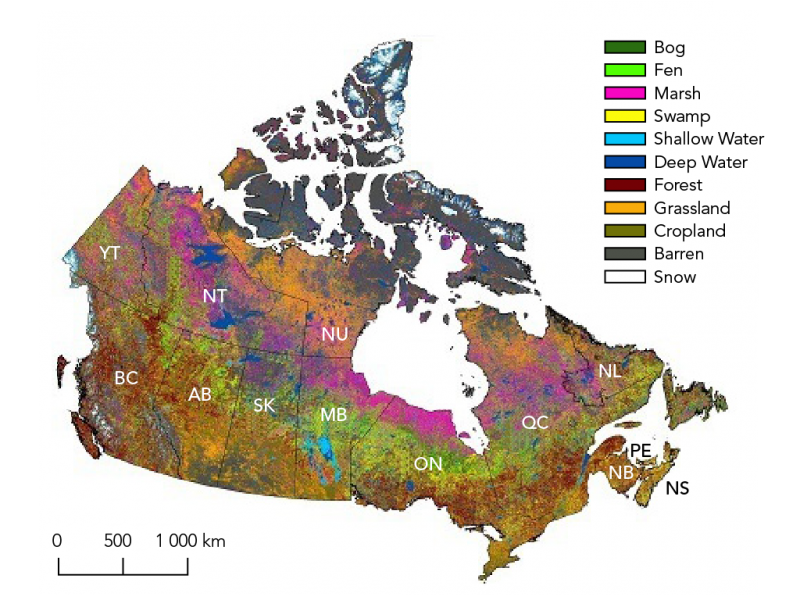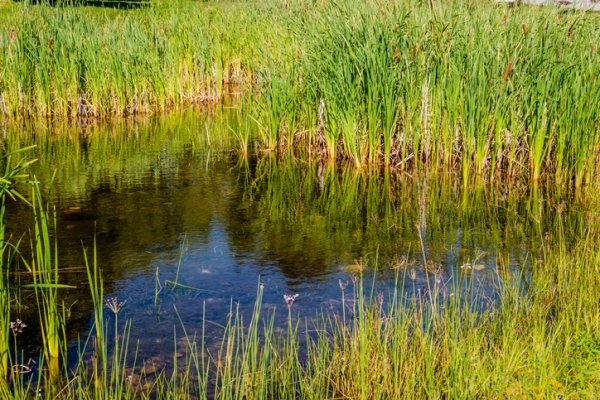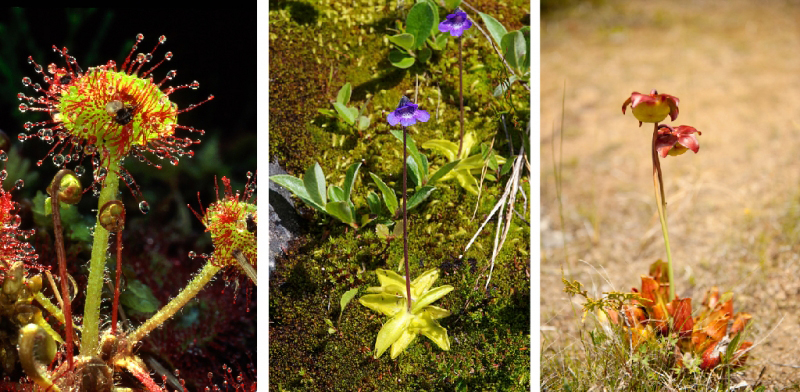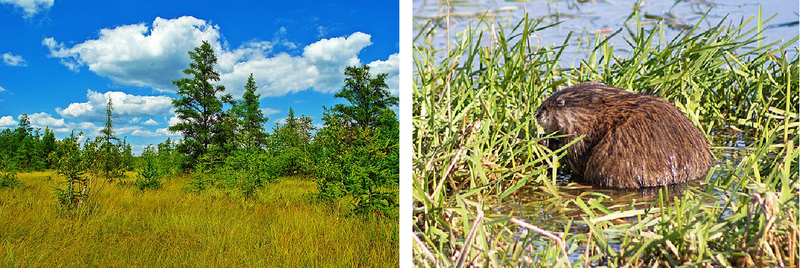Introduction to Freshwater Wetlands
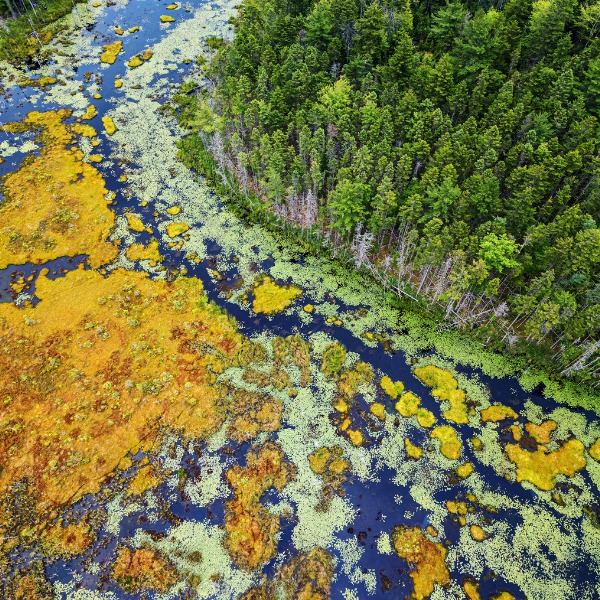
Aerial view of a wetland (shaunl, iStockphoto)

Aerial view of a wetland (shaunl, iStockphoto)
How does this align with my curriculum?
Learn about the geology, chemistry and ecology of freshwater wetlands.
Wetlands
Wetlands are habitats that are either under water, or soaked with water part of the year. Freshwater wetlands include marshes, swamps, bogs and fens.
Geography
Canada has about 1.29 million km2 of wetlands. This covers 13% of Canada's land. And this is about 25% of the wetlands in the world.
25% of Canada's wetlands are in the Boreal Shield. 21% are in the Hudson Plains. 18% are in the Boreal Plains.
Image - Text Version
Shown is a map of Canada with colours representing types of wetlands. In the top right corner, a legend indicates which colour represents which type of wetland. The colours are mottled together across the country, but some patterns are visible. Starting at the top, the northern parts of the arctic islands are white, indicating “Snow.” Most of the rest of the high arctic is dark grey, representing “Barren.” Mainland Nunavut, northern Québec and Labrador are orange, representing “Grassland.” Below this, a strip of pink crosses through the Northwest Territories, southern Nunavut, and northern Saskatchewan, Manitoba, Ontario, Québec and Labrador. This represents “Marsh.” Along the lower edge of this, a thinner strip of light green goes from Yukon, through the eastern Northwest Territories, northern Alberta, Saskatchewan, Manitoba, Ontario and Québec, and southern Labrador. This represents “Fen.” Clumps of brown appear in northern B.C., Alberta, Saskatchewan, Manitoba, Ontario, Québec and Atlantic Canada. This represents “Forest.” Southern parts of the southern provinces are mottled in brown, orange, and grey, representing forest, grassland, and barren.
Did you know?
Almost 80% of the Hudson Plains is wetland. The Hudson Plains curve around Hudson Bay and James Bay. They include land in eastern Manitoba, northern Ontario and western Quebec.
There were once many wetlands all over Canada. But over time, wetlands are becoming more rare. In southern Ontario, 68% of the original wetlands have been converted from their natural state. They are now used for things like agriculture and housing. In southwestern Manitoba, only about 25% of the original wetlands in the ‘Prairie Pothole’ region remain. The good news is that in the northern part of Canada, most of the wetlands are intact.
Chemistry
Just because an area is wet, doesn’t mean it’s a wetland. The amount of water in a wetland can change depending on temperature and precipitation. This means we need to look at other things to determine if an area is a wetland or not. One way is to examine the soil.
Wetlands have hydric soils. These are soils that formed in saturated conditions. Hydric soils are anaerobic. This means they contain very little oxygen.
The lack of oxygen means this soil has different colours and textures than aerobic soils. Aerobic soils have large amounts of a form of iron (Fe). This makes it a yellow, orange or reddish colour. Anaerobic soils have a different form of iron. This gives them a grey colour.
Plants that grow in wetlands have special adaptations. These allow them to grow in low-oxygen conditions. Cattails and bulrushes have these adaptations. If you see cattails and bulrushes, this is a good indication that the area is a wetland.
Image - Text Version
Shown is a colour photograph of tall, thin green plants growing in water. In the centre of the image is a dark, calm body of water. Around it, to the edges of the image, are tall plants with long thin leaves. They look a bit like long green grasses growing out of the water. Some of the plants are topped with spindly, pale, spiky looking flowers. Others have brown cylinders with rounded ends.
Ecology
Wetlands are important to many animals. Some of these might be familiar to you.
Every drop of water contains microscopic phytoplankton and zooplankton. These are important parts of the food chain. Phytoplankton are microscopic algae that can create their own food. Zooplankton are microscopic animals that eat phytoplankton.
The surface of the water and the wetland bottom are covered with insect eggs, larvae, and nymphs. Fish, amphibians, and reptiles depend on the habitat provided by wetlands. Many bird and mammal species also use the water and the nearby shore.
Let’s look more closely at the different types of wetlands and some of the plants and animals found there.
Marshes
Marshes are permanently or regularly covered in standing or slow-moving water. Marshes are rich in nutrients.
They have many kinds of emergent vegetation. These are plants that grow up through the water. They include reeds, rushes, cattails and sedges. The roots of these plants are covered in water for most of the growing season. Marshes are the most productive type of wetlands. This means they produce more organic matter than other wetlands.
Marshes are home to many protected species. These include the Bald eagle, Sandhill crane, Eastern fox snake and Fowler’s toad.
Image - Text Version
Shown are three side-by-side colour photographs of protected animals. The left image shows a large bird with a brown body, white head and hooked beak, flying across a green landscape. The middle image shows a brown snake with dark brown spots, coiled in short green grass. The right image shows a toad with bumpy, light brown skin, sitting among twigs and leaves.
Swamps
Unlike marshes, swamps have trees and shrubs. Swamps may be flooded seasonally, or for long periods of time. Like marshes, swamps are also nutrient-rich and productive.
Swamp plants include both coniferous, or cone-bearing trees and deciduous, or leaf-dropping trees. Swamps are most common in the southern part of Canada. Swamps are home to many protected species. These include the Eastern prairie fringed orchid, Loggerhead shrike, Red-shouldered hawk and Blanding’s turtle.
Image - Text Version
Shown are three side-by-side colour photographs of different plants and animals found in swamps. The left image shows a pale grey bird with a long black tail, sitting on a fence post. It has stripes of black over its eyes and along the edge of its wings. The centre image shows a green plant with many small frilly white flowers, arranged around the top of the stem. The right image shows a turtle with a dark brown and beige shell just visible among twigs and leaves on the ground.
Bogs
Bogs are also known as peat bogs. They are a kind of peatland. Peatlands are wetlands that contain peat. Peat is a build-up of partly-decayed plants. The top 30 to 50 cm of a peatland is made up of mosses and other living plants. Under that layer is the peat, which can be up to 10 metres deep!
Did you know?
In some parts of the world, dried peat is harvested as a source of fuel!
In a peatland, the peat acts like a giant sponge. This makes it hard for water to drain through it. Poor drainage and decaying plant material makes bogs very acidic. The water in bogs only comes from precipitation.
The high acidity and low oxygen in bogs makes it very difficult for plants to grow. This is why the biodiversity in peatlands is low.
The main kinds of vegetation in bogs are sphagnum mosses. Mosses are small, soft plants with small leaves. Mosses do not have roots. They absorb water through their leaves instead.
Shrubs like heaths can also be found in bogs. Heaths have adaptations for living in acidic soil. Other bog plants include cotton grass, cranberry, bog laurel, leatherleaf, blueberry and Labrador tea.
Image - Text Version
Shown are two side-by-side photographs of peatlands. The left image shows flat, rolling land covered in a carpet of green, gold and orange mosses. The right image shows a person wearing rubber boots, bending down to the ground. The land is mostly flat and covered with low green plants. A trench has been sliced into the land to reveal layers of brown underneath the surface.
Carnivorous plants also live in bogs. These include plants like sundews, butterworts and pitcher plants. Carnivorous plants are interesting. They get some of the nutrients they need by catching and digesting small insects and spiders. They can do this by catching them in sticky liquid or by trapping them in their leaves.
Image - Text Version
Shown are three side-by-side colour photographs of different carnivorous plants. The first image shows a pale green plant with hairy stems. The tops of several stems have round, green donut-like structures dotted with what look like bright red whiskers. All of these are covered with drops of shiny liquid. The centre image shows two plants with tall, thin, reddish stems and small, bright purple flowers. Each one has pale green leaves fanned out around its base. The right image shows a plant with a pale green stem. This is topped by two green bulbous structures that hang down from the stems on a crown of small, pointed, reddish leaves. The plant’s base is surrounded by stubby orangish red leaves.
Did you know?
Peatlands cover over 1.1 million square kilometres, or about 12 percent of Canada.
Bogs provide habitat for both migratory bird species and permanent residents. These include palm warblers, Lincoln’s sparrows, tree swallows and northern harriers.
Some large mammals also live in bogs. These include moose, White-tailed deer, Wood bison and caribou. Small mammals like Bog lemmings, Southern bog lemmings and Arctic shrews prefer bogs to other types of habitats.
Fens
Fens are also a type of peatland. Unlike bogs, fens are fed by surface water and groundwater. This means the soil there is less acidic. Fens are not as low in nutrients as bogs, so they are more productive.
The main kind of plant growing in fens are sedges. Trees like cedars, dwarf birches, Black spruce, and Tamarack can also grow here.
Image - Text Version
Shown are two side-by-side colour photographs. The left image shows coniferous trees scattered over flat land with long green and yellow sedges. The right image shows a wet, furry brown animal crouched in water. Around it, long green leaves grow up through the water.
Fens are more common in the northern part of Canada. Birds found in fens include Virginia rails, yellow warblers and swamp sparrows. Mammals include water shrews, star-nosed moles and muskrats.
Did you know?
Peatlands are also called muskegs. This comes from the Cree word maskek and Ojibwe word mashkiig, meaning “grassy bog.”
Learn More
What are peatlands and why are they under threat? (2021)
This video by CBCSaskatchewan (3:30 min.)explains how muskegs develop, how they capture carbon, and why groups are opposed to companies harvesting peat moss from them.
Wetlands
This article from Canadian Wildlife Federation has information, videos, images and audio clips from Canada’s wetlands.
Northern Peatlands in Canada (2021)
This story map from Wildlife Conservation Society Canada illustrates the northern peatlands of Canada and explains why they are so important for both climate and biodiversity.
Muskeg (2018)
This article from the Canadian Encyclopedia explains the origin of the word muskeg, how muskeg is formed and why it’s important.
References
Amani, M. et. al. Canadian Wetland Inventory using Google Earth Engine: The First Map and Preliminary Results. Remote Sensing. 2019, 11(7), 842; https://doi.org/10.3390/rs11070842
Government of Canada. (2016, January 14) Water sources: wetlands. Canada.ca.
Hinterland Who’s Who. (n. d.). Introduction What are wetlands? Where are the wetlands?
Lahey, A. (2019, July 25). Wetland who's who: Do you know your bogs from your fens?. Cottagelife.com.
Langlois, A. (2013). Peatlands. Hinterland Who’s Who.
National Wetlands Working Group. (1997). Canadian Wetland Classification System. Wetlandpolicy.ca.
Science Direct. Wetland Soil - an overview.
Southee, M. (2020, April 30). It’s time to start paying attention to Canada’s peatlands. Canadian Encyclopedia.
